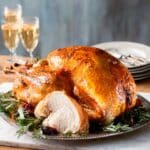Description
This Herb and Salt-Rubbed Dry Brine Turkey recipe delivers a deeply flavorful and juicy roast turkey through a days-long dry brining process using fresh and dried herbs combined with kosher salt. The method involves rubbing the turkey under its skin with an aromatic herb and olive oil blend, followed by a multi-day refrigeration that allows the salt and herbs to penetrate the meat, resulting in enhanced moisture retention and savory taste. Roasting the turkey in the oven with convection settings guarantees a perfectly cooked bird with crisp skin and tender meat, making it an ideal centerpiece for special occasions and holiday dinners.
Ingredients
Scale
Herb Mixture
- 2 tablespoons chopped fresh thyme
- 2 tablespoons chopped fresh sage
- 1 tablespoon chopped fresh rosemary
- 1 tablespoon dried marjoram
- ½ tablespoon dried oregano
- 1 tablespoon extra-virgin olive oil
Turkey
- 1 whole 16-lb turkey, thawed or fresh (preferably fresh, not kosher or self-basting)
- ¼ cup Diamond Crystal Kosher Salt (use less if using Morton’s kosher salt)
Instructions
- Prepare the Herb Rub: Four days before roasting, combine chopped fresh thyme, sage, rosemary, dried marjoram, dried oregano, and extra-virgin olive oil in a small bowl. This herb oil mixture will infuse the turkey with deep, aromatic flavors during the dry brine.
- Prepare the Turkey: Remove the neck and giblets from the turkey cavity and set aside if desired for stock. Carefully loosen the skin around the shoulders, breast, thighs, and drumsticks by sliding your hands gently underneath to separate the skin from the meat without tearing it. This will allow the herb mixture to penetrate the meat directly.
- Apply Herb Rub: Rub the herb and olive oil mixture liberally under the skin on the breasts, thighs, and drumsticks, spreading evenly to coat the meat. Return the skin to its original position and gently pat it down to secure the herbs beneath.
- Salt the Turkey: Rub kosher salt evenly inside the cavity and over the skin of the turkey. This salt application will function as the dry brine, drawing moisture out and then reabsorbing it to keep the meat juicy and flavorful.
- Truss and Bag: Tuck the wing tips behind the neck, tie the legs together securely with kitchen twine, then place the turkey in a large food-safe plastic bag such as a turkey-size roasting bag. Tie the bag closed tightly and place it inside a second bag for extra protection. Tie the second bag securely.
- Refrigerate and Turn: Place the double-bagged turkey on a rimmed baking sheet and refrigerate. Each day for the next three days, turn the turkey over within the bags to ensure even distribution of the brine and herbs.
- Air-Dry: On the fourth day, remove the turkey from the bags and pat it dry with paper towels. Transfer it to a large roasting pan and refrigerate uncovered overnight to allow the skin to air dry, which will help achieve a crispier skin after roasting.
- Temper the Turkey: About 1 to 3 hours before roasting, remove the turkey from the refrigerator and let it come to room temperature on the counter. This ensures more even cooking.
- Prepare for Roasting: Place the turkey breast side up on a roasting rack sprayed lightly with oil, set inside a shallow roasting pan approximately 2 to 2½ inches deep. Position a rack in the bottom third of your oven and preheat the oven to 350°F using the convection roast setting if available.
- Roast the Turkey: Insert a probe thermometer into the thickest part of the thigh without touching the bone and set it to 170°F. Roast the turkey until the probe reaches this temperature, which generally takes about 1½ to 2 hours or longer depending on the bird’s size. Alternatively, if not using a probe, roast at 425°F for 1 hour then reduce the heat to 325°F and continue roasting until an instant-read thermometer registers 170°F in the thigh, typically 1¾ to 2 hours total.
- Rest Before Carving: Remove the turkey from the oven and let it rest for 30 minutes before carving. This resting period allows the juices to redistribute throughout the meat, enhancing moistness and flavor for serving.
Notes
- You can customize the herb blend by adding garlic powder, lemon zest, freshly ground black pepper, dried bay leaf, or other herbs and spices to suit your taste preferences.
- Choosing fresh, non-kosher, unfrozen (or properly thawed) turkey is recommended for best results with this dry-brine method.
- Tying the legs and tucking wing tips helps the turkey maintain shape during brining and roasting.
- Using a probe thermometer ensures perfectly cooked juicy meat without overcooking.
- The overnight air-dry step is crucial for crispy skin; do not skip it if possible.
Nutrition
- Serving Size: 6 oz turkey breast no skin
- Calories: 225
- Sugar: 0 g
- Sodium: 896.5 mg
- Fat: 3.5 g
- Saturated Fat: 1 g
- Unsaturated Fat: 2.5 g
- Trans Fat: 0 g
- Carbohydrates: 0 g
- Fiber: 0 g
- Protein: 45.5 g
- Cholesterol: 121 mg

